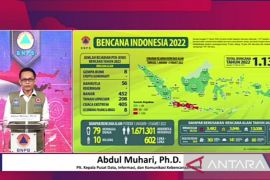Floods and landslides were mainly triggered by relatively high precipitation during the ongoing rainy season.
Since the beginning of the rainy season in November 2012, floods and landslides have been reported in many provinces such as Jakarta, Jambi, Papua, West Java, South Sumatra, West Sumatra, Lampung, Banten, East Java, Central Java, Gorontalo, Aceh, North Sulawesi, and East Nusa Tenggara.
In Jakarta alone, at least 20 people were reportedly killed in major floods that paralyzed the capital city and surrounding areas, forcing the Jakarta Governor to proclaim a ten-day state of emergency from January 17 to 27, 2013.
Also last January, in many Indonesian regions, ships and boats could not sail and fishermen were warned to be cautious due to strong winds and huge waves as the impacts of Cyclone Narelle that had hit Australia and Typhoon Bopha in the Philippines - both are Indonesia`s immediate neighbors.
A number of buildings were damaged and several people were killed by whirlwinds particularly in South Sulawesi.
The latest disaster was reported in Manado, North Sulawesi, where floods and landslides claimed 17 lives and displaced around 1,700 people since Saturday (Feb 16).
In a plenary cabinet meeting in Jakarta, Monday (Feb 18, 2013), President Susilo Bambang Yudhoyono reminded the Indonesian people that floods and landslides occurring in several Indonesian regions lately have indicated that natural disasters are not over yet in this country and therefore the people must always be on full alert.
"I remind you that Indonesia is not yet safe from natural disasters," President Susilo Bambang Yudhoyono.
When opening a two-day Global Thematic Consultation on Disaster Risk Reduction and the Post-2015 Development Agenda in Jakarta on Tuesday (Feb 19, 2013), the president said that the linkage between development agenda and disasters has been well established, as disasters can destroy development gains.
Discussion on "Disaster Risks Reduction" is crucial for countries like Indonesia and many others in Asia and the Pacific which are prone to natural disasters, according to him.
The head of state said Indonesia has mainstreamed disaster risk reduction (DRR) in its national development program. The country has also included DRR in its National Disaster Management Plan of 2010-2014 and the National Action Plan for Disaster Risk Reduction.
Learning from the experiences of the deadly tsunami that hit Aceh and Nias in 2004 as well as the 2006 Yogyakarta earthquakes, Indonesia continues its efforts to achieve national and local disaster resilience.
Evidence shows that the frequency of natural disasters has increased significantly since 1970s. It was also reported that in 2010 alone, over 42 million people were displaced by natural disasters, he added.
According to United Nation of Environment Program (UNEP), the Asia-Pacific comprises over 50 percent of the earth`s surface, 40 percent of the global population and experiences more than 70 percent of all natural disasters.
In 2008 alone, the region accounted for more than half of the 220 major disasters that took place, which affected more than 55 million people and resulted in 7,000 deaths and US$15 billion in damages.
Worldwide, 231 disasters caused 5,469 deaths, affected 87 million people and caused $44.6 billion in economic damages in January-October 2012.
Meanwhile, AlertNet quoting a study reported that natural disasters killed fewer people in Asia in 2012 but affected far more than in previous years and caused serious economic damage.
"What we`re seeing is credible proof that fewer people are dying. It`s something to celebrate that the early warning and preparedness are working," said Jerry Velasquez, head of the UNISDR in the Asia Pacific region.
From January to October this year, 83 natural disasters in Asia caused 3,103 deaths, affected 64.5 million people and caused $15.1 billion in damages, the United Nations agency for disaster reduction (UNISDR) and the Louvain University Centre for Research on the Epidemiology of Disasters (CRED) in Belgium said.
In the decade from 2002 to 2011, the death toll from disasters in Asia averaged 6,664 people per year, and the number affected by disasters averaged about 22 million, making it the region most severely affected by natural calamities.
Floods are the main threat in Asia, making up 44 percent of the region`s disasters and more than half of the death toll and economic losses. The three Asian countries with the largest number of natural disasters in 2012 were China, the Philippines and Indonesia.
Indonesia as the Asia Pacific Economic Cooperation (APEC) Chair 2013 has proposed better emergency preparedness as one of the priority agenda of APEC because the issue is vital to resilient Asia-Pacific.
During the APEC Senior Official Meeting in Jakarta, January 25-February 7, 2013, APEC Officials from the world`s most natural disaster prone region discussed the next step to address customs and immigration bottlenecks to facilitate travel for emergency response in the Asia Pacific.
"APEC has a mechanism called APEC Business Travel Card that allows business travelers to have a pre-cleared, facilitated short-term entry to participating member economies. We can adopt this mechanism and apply it on our effort to help member economy being impacted by natural disaster," the Indonesian foreign ministry`s Asia Pacific and African Affairs Director General Yuri Thamrin said in the meeting in early February.
The APEC Emergency Preparedness Working Group will hold a meeting alongside the Third APEC Senior Officials` Meeting and related meetings in Medan, Indonesia, from June 22 to July 6, 2013. ***4***
(T.F001/A/F001/O001) 20-02-2013 10:19:54
Reporter: by Fardah
Editor: Fardah Assegaf
Copyright © ANTARA 2013











